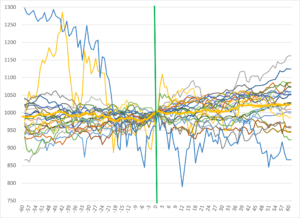One of the most common questions our advisors have been asked in the past couple months is: Should we be moving our investments to cash due to the upcoming election?
And while our answer consistently has been that this election carries a tremendous amount of emotional, social, and economic uncertainty, traditionally presidential elections are short-term events that do not result in market moves that require adjustments away from your long-term investment & financial goals.
But is that true?!? Today we will investigate.
For our research, we are going to look at all presidential elections from 1928 – 2016 and the corresponding performance of the S&P 500 Index 60 days leading up to the election and 60 days following the election. The chart below shows the performance for each election year with the average performance being the bold orange line. The vertical green line represents election day.
As you will notice most years fall within a reasonable range of volatility leading up to election day. We have 2 key outliers in yellow and blue. The yellow line represents 1932 and the blue line represents 2008. And while the election each of these years may have contributed to the level of market volatility, we believe the Great Depression (1932) and Financial Crisis (2008) represented the primary thesis behind these two outlier events.
To find our baseline expectation for the S&P 500, we analyzed the performance of the 60 days preceding and following what would be election day every year from 1928 – 2019. Here are the results:
| 60 Day Performance Preceding ‘Every Year’ | 60 Day Performance Following ‘Every Year’ | 121 Day Performance ‘Every Year’ | 121 Standard Deviation ‘Every Year’ |
| +0.45% | +2.71% | +3.52% | 20.0% |
Now, how does the 121-day period (60 days preceding, election day, and 60 days following) in election years compare to the same period in all years we reviewed above?
| 60 Day Performance Preceding ‘Election Year’ | 60 Day Performance Following ‘Election Year’ | 121 Day Performance ‘Election Year’ | 121 Standard Deviation ‘Election Year’ |
| +1.64% | +2.16% | +4.07% | 15.7% |
What we find is that while performance varies leading up to and following election day, the entire 121 period during election years is relatively similar (slightly better) to the performance of that same 121 period during non-election years. What was surprising is that one would think the uncertainty of an election would create higher levels of volatility, but actually we find volatility during election years is 1/5th less when compared to the same period during all years!
That brings the question of ‘is it different this time’? One major variation we wanted to check is the result of increased uncertainty… Essentially, what happens when the Presidency switches from Democrat to Republican or vice versa. Under this circumstance, you might expect heightened volatility since there could be concern over changes in political and economic agendas from the prior 4-8 year period. When this event occurs we find the following results:
| 60 Day Performance Preceding ‘Change in Power’ | 60 Day Performance Following ‘Change in Power’ | 121 Day Performance ‘Change in Power’ | 121 Standard Deviation ‘Change in Power’ |
| -2.47% | +0.69% | -1.55% | 19.9% |
Under increased uncertainty, we do find negative equity performance leading up to election day with a change in presidential party. And while volatility is higher than all election years, it is in line with market volatility when considering election and non-election years. One item to note is this grouping includes 2008, a highly volatile down period which significantly skews the results.
Where Do We Stand Today?
Now that we’ve found evidence that elections have very minimal effect on the performance of the S&P 500 Index, where do we stand today?
As of this writing, we are 26 market days away from the next election. The first 34 days (of the 60-day preceding the election) have produced a -0.26% return with slightly elevated volatility at 20.3%. While negative market performance can be concerning, we feel portfolio adjustments based on these short-term conditions is likely unwarranted.
This time ‘it may be different’, but history has shown us that elections rarely, if ever, have had a significant negative impact on the S&P 500 during the 60 days preceding or following election day. If you have any questions about your portfolio or long-term financial plan, please contact your Innova Wealth Partners advisor as we are always here to help!
DISCLOSURE
Innova Wealth Partners, LLC (“Innova”) is a registered investment advisor. Information presented herein is for educational purposes only and does not intend to make an offer or solicitation for the sale or purchase of any specific securities, investments, or investment strategies. Investments involve risk and unless otherwise stated, are not guaranteed.
Readers of the information contained on these performance reports, should be aware that any action taken by the viewer/reader based on this information is taken at their own risk. This information does not address individual situations and should not be construed or viewed as any typed of individual or group recommendation. Be sure to first consult with a qualified financial adviser, tax professional, and/or legal counsel before implementing any securities, investments, or investment strategies discussed.
S&P 500 Index widely regarded as the best single gauge of the U.S. equities market, this index includes a representative sample of 500 leading companies in leading industries of the U.S. economy. Although the S&P 500 focuses on the large-cap segment of the market, with over 80% coverage of U.S. equities, it is also an ideal proxy for the total market.

